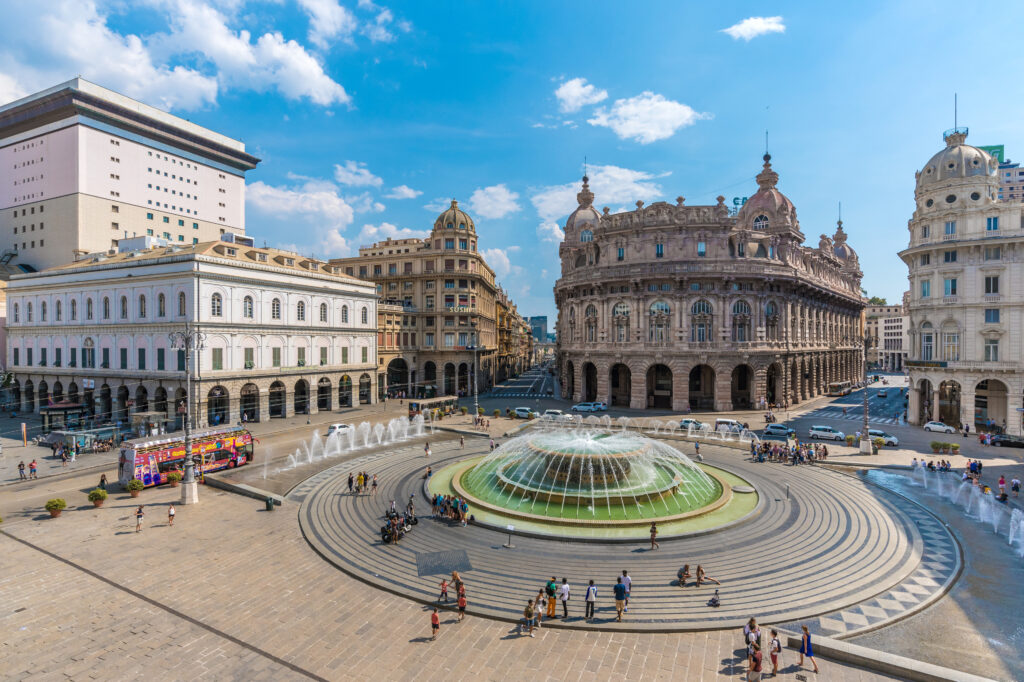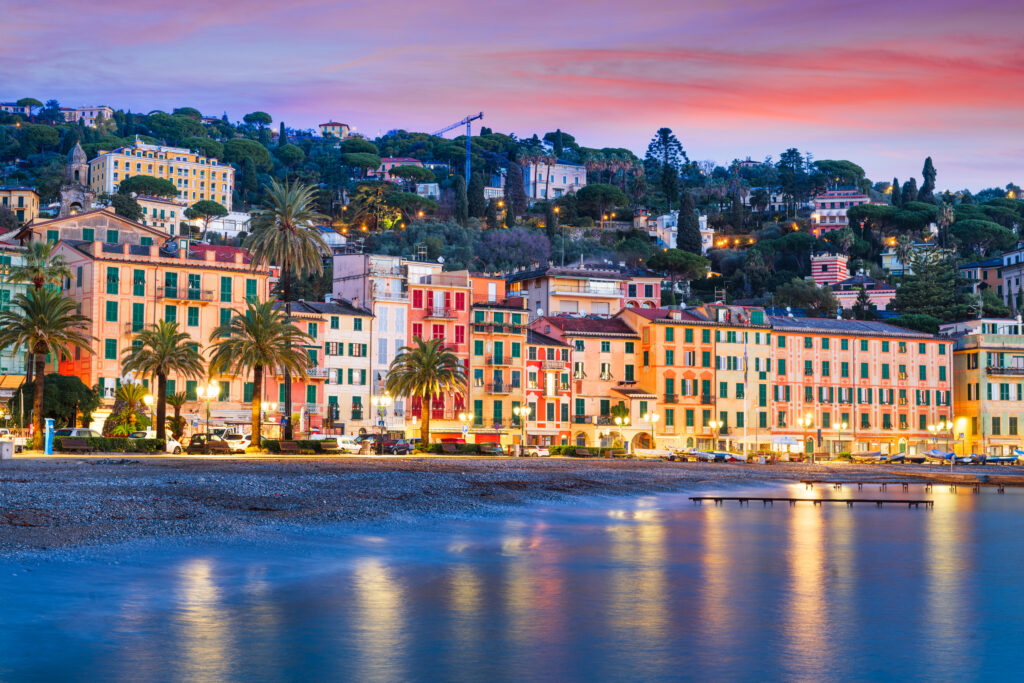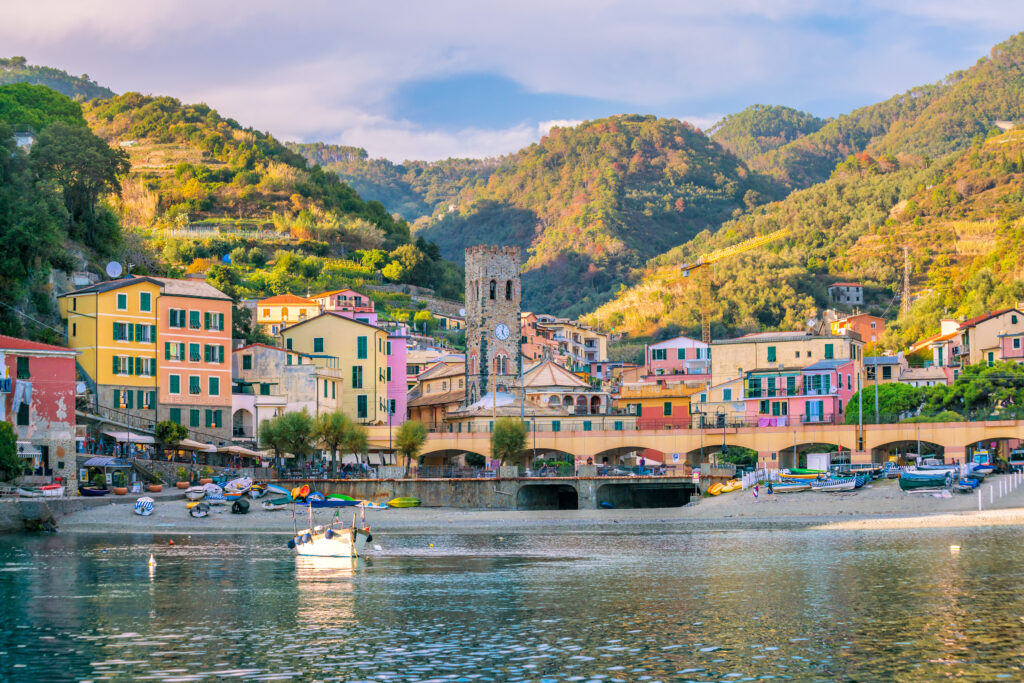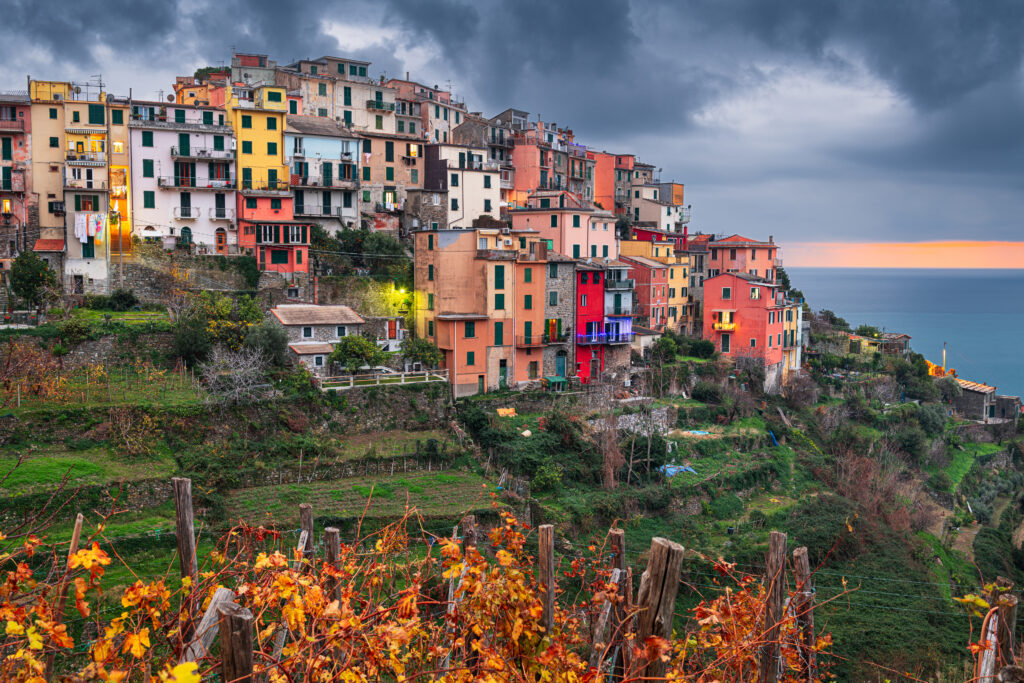
A Visitor’s Guide to Liguria
With its jagged coastline, villages overlooking the sea, and rich and elegant neighborhoods, Liguria is like a jewel set between land and sea. Liguria is a particular region with a thousand aspects. It has an elongated shape, and Genoa, the regional capital, is located more or less in the center of this strip. Genoa extends concurrently with the coast. The coast represents one of the most beautiful stretches of the Mediterranean, with a turquoise sea and beaches set between overhanging rocks.
Due to its strategic position and small but varied territory, Liguria offers visitors much to see between coastal beauties and inland gems. Characterized by pastel colors, this Italian region is famous worldwide for its scenic, cultural, and artistic beauty. Liguria continues to enchant thousands of visitors every year. On one side, you have the stunning azure sea. On the other, the mountains with their particular conformation of terraces created by the farmers who have found space where there was none before. Is Liguria on your travel bucket list? Read on to see what the region has to offer.
Genova
Genova alone is worth a trip to Liguria. The historic center is a fascinating part of the city, formed by a dense network of tiny alleys called carruggi. You can see majestic squares between one carruggio and another, with monuments and churches that guard them. Genova is rich in history and offers an architectural heritage. Not to be missed are the Cathedral of San Lorenzo, the magnificent Palazzo Ducale, and the beautiful Palazzi dei Rolli. The Palazzi dei Rolli are about one hundred buildings now used as museums, and also a UNESCO World Heritage Site. As for the Cathedral, admission is free, but for six Euros, you can also visit the Diocesan Museum and the Treasure Museum. Surely worth the cost.
The main square of Genoa is Piazza De Ferrari, the commercial, economic, and social center of the city, a reference point for every event that takes place in Genova. Piazza De Ferrari also has different architectural styles, ranging from the eclectic to the neoclassical.
The Genovese Cuisine
Genova is the homeland of the classic Genoese focaccia, made with flour, water, coarse salt, and extra virgin olive oil, the traditional process, with long leavening that lasts about 8 hours. It is also a Slow Food presidium, as are Monterosso salted anchovies, Albenga violet asparagus, Vessalico garlic, and Badalucco, Conio, and Pigna beans.



Portofino
Among the area’s most sought-after destinations is the small village of Portofino. This magnificent village, nestled in greenery, is one of the most exclusive tourist resorts in the world and attracts thousands of visitors every year, including artists and celebrities.
A famous seaside village, Portofino is the symbol of elegance and embodies Italy’s La Dolce Vita perfectly. It is a small village, dominated by a small square overlooked by restaurants and exclusive shops. Just 400 permanent residents call Portofino home. However, visitors flock by the thousands in the summer months. You will find Portofino National Park in Portofino, a natural area with a breathtaking path that will take you to the top and allow you to enjoy a spectacular view of the bay. Those physically fit can enjoy a hike here and be stunned by the majestic views. Those less active can enjoy a particular cooking class in Portofino Natural Park, where a specialized vehicle takes you to the top, and you’ll still be rewarded with the same views!
The village offers natural beauty, glam shops, and a lot of culture, thanks to its monuments. From the frescoed Church of San Martino to the Church of San Giorgio just outside the historic center. And again, the Hermitage of Sant’Antonio di Niasca from the 13th century, the Brown Castle from the 16th century, and the Battery of Punta Chiappa. Portofino is a place not to be missed to be able to immerse yourself in the atmosphere of luxury and extravagance, thanks to the presence of numerous celebrities who flock to the small village every year.



San Fruttuoso and its Abbey
San Fruttuoso is an incredible location hidden in a small cove on the Portofino peninsula. Here, hidden between the Portofino National Park‘s greenery and the sea’s deep blue, lies the famous Abbey of San Fruttuoso Capodimonte. The Abbey of San Fruttuoso is undoubtedly one of the main attractions not to be missed.
The Abbey is a Romanesque monastery dating back to the year 1000, built close to the sea. There are only two ways to reach it: a walk with a nature trail or arriving by sea on a boat. The latter option is the most comfortable and picturesque since the hike can take several hours!

Santa Margherita Ligure
Santa Margherita Ligure rises between Portofino and Camogli and represents the typical Ligurian seaside town. This is the perfect base if you plan on spending a week on the Riviera. Surrounded by hills covered with Mediterranean vegetation, you will find villas and gardens overlooking the coast. Here it is possible to stroll in the parks along the seafront, safely walk along the streets in the center, or walk along the old alleys that go up from the castle to the convent of the Capuchin Fathers or up to the Church of St. Giacomo di Corte.
One of the symbols of the city is the 17th-century Villa Durazzo. Villa Durazzo-Centurione is part of a single complex consisting of two villas, the castle, and a beautiful park with an Italian garden and paths in the typical Ligurian cobblestone called risseu. The 17th-century frescoes you’ll find inside are simply beautiful. While stunning, Villa Durazzo is a magnificent palace often overlooked by visitors. Its gorgeous park is always open and offers a fantastic opportunity to escape the crowds that invade Santa Margherita Ligure in the summer.
Worth mentioning is the Castle, a small building in the city’s center. The Genoese built it in 1550 for defensive purposes. At that time, raids by Saracen pirates were quite frequent. The Genovese restored it at the turn of the century, and today the castle is used to host events and exhibitions. The Church of San Giacomo di Corte is worth visiting; built in the 17th century, but its origins are much older. The structure is divided into three sections. It houses the famous statue of the Madonna della Lettera and the frescoes by Nicolò Barabino.


Rapallo
Thanks to its strategic position between Portofino and Santa Margherita, Rapallo is an exciting destination for those wishing to enjoy the sea and the land. The pedestrian alleys of the medieval village have now become the streets for strolling and shopping and to be seen. The historic shops that sell food products and the typical Ligurian focaccia flank the elegant and fashionable boutiques where you can treat yourself to something special.
Lungomare Vittorio is the promenade to enjoy a stunning walk, set between the sea and the Art Nouveau buildings flanked by palm trees and flower beds, offering a beautiful view over the entire gulf. It is considered the “living room” of Rapallo, and here you will find numerous restaurants where you can sit and people-watch, Italy’s favorite pastime.
Located in the historic center, you will find the Basilica of Saint Gervasio, and Saint Protasio. Built during the Middle Ages in Gothic-Romanesque style, the exact date is not precise. However, inside, there is an inscription that dates back to 1118.

Camogli
Just under 15 miles from Genoa stands the beautiful village of Camogli, with its small and cozy port surrounded by typical colored houses, a symbol of this particular area. It is a very picturesque seaside village whose landscape looks like a postcard. Get your camera ready if visiting this picturesque destination. Camogli is the ideal destination for a day trip on the beach and to discover this small town believed to be one of the most beautiful in Italy. It is a magnificent seaside destination, with deep blue waters against the backdrop of the orange, yellow, and red of the houses and the green of the land.
The Basilica of Santa Maria Assunta is the church that appears in the most famous images of Camogli. But, as stunning as it is on the outside, take your time visiting the interior! Built in the 12th century on a rock overlooking the sea, the internal of the Basilica is composed of three sections in Baroque style, enriched with gilded stuccos and crystal chandeliers. Inside there are numerous works of art and precious frescoes from the 1500s.
In Camogli, there is always something to discover and explore. Enchanted panorama, visits to castles and museums, and savoring the flavors of this majestic place are only a few of the things you can do in Camogli.

The Cinque Terre
Spread over a landscape of about six miles, Monterosso al Mare, Vernazza, Corniglia, Manarola, and Riomaggiore make up the famous Cinque Terre. The Five Lands, one of the most sought-after tourist destinations in Italy, are famous all over the world. They have been part of the UNESCO World Heritage since 1997. Indeed this is what most people think of when they think of Liguria. Each unique in its own way, the Cinque Terre are on everyone’s must-see list, and they certainly should be on yours.
Monterosso
Monterosso is undoubtedly the most touristy since it offers the most famous beach. However, its seafront and the Church of San Francesco make the landscape even more magical. With a landscape containing olive groves, vineyards, and lemon trees, surrounded by the sea, you can enjoy the scent of this small town for miles.

Vernazza
Vernazza is a beautiful town, an ideal starting point for long walks. It is full of pedestrian paths, including the well-known Sentiero Azzurro, which connects it to other villages of the Cinque Terre. Although its small port captures visitors’ attention, Vernazza offers small historical and architectural gems. Among them, the Sanctuary of the Black Madonna, which, once reached, offers an unmissable view of Vernazza.

Corniglia
Corniglia, located between the five lands, is the most particular of the Cinque Terre. You can reach the top of the hill via a long staircase of about 400 steps. It is the only one that does not have direct access to the sea. From the Belvedere di Santa Maria, you can however, enjoy a spectacular view of it. Corniglia represents the heart of Cinque Terre and is a delight for strolling through its alleys. It’s the quietest of the five lands because reaching it is the most challenging of the area.

Manarola
Manarola welcomes visitors with views of tall and narrow houses in pastel tones perched on the mountains. This is the one land, among all the five, best embodies the perfect mix of sea and land, between new and old. Its terraces overlooking the sea are the most famous of the Riviera and, among the most exciting points for unforgettable views, we find Piazza Castello and Piazza De André. Manarola is also the place to visit if you enjoy light sweet wines like me. Sciacchetra is a sweet wine strictly made from grapes grown in this area.

Riomaggiore
Riomaggiore is the last of the Cinque Terre, the largest and the most famous of the five lands. The first natural attraction in Riomaggiore is its excellent historic center. Situated between two valleys, the colored houses in the center are perched on the rocky cliffs, and it seems almost impossible to have been built here. Enjoy a walk through its streets, and then admire the sea view from the small port area. The Church of St. John the Baptist is the main church of Riomaggiore, which dominates the entire historic center from above. The best moment to appreciate the view of Riomaggiore is undoubtedly the sunset.
While it is possible to visit all of the Cinque Terre in one day, it makes for a long and less-than-ideal day! One I would not recommend. Visitors should either select a few of the central lands that are easily accessible or select to spend a few nights in Riomaggiore, where you will find several reputable hotels.

Ligurian Cuisine
Ligurian cuisine boasts delicious dishes prepared with simple, local ingredients. In Liguria, the star is pesto! To make it according to tradition, you need Genoese Basil, produced on the Tyrrhenian side of the region. Pesto is usually served with pasta, especially trofie, but you can enjoy it with bruschetta or a simple slice of toasted bread.
Another dish found here is Farinata, a straightforward food made with chickpea flour and oil, typically eaten as street food in Liguria.
To represent the sea, you will find an array of seafood in Liguria. Fried squid and anchovies, as well as the stockfish, served as flan and accompanied by olives, will find their way on many menus in the area.
Are you looking to make Pesto alla Genovese at home? I’ve included the recipe from my first cookbook: The Five Ingredient Italian Cookbook, below! Summer is almost here, the perfect use for all your basil growing in your yard and potted plants, even if it’s not Genovese basil, I promise not to tell!

Ready to visit Liguria for yourself? I’ll be running a week-long culinary and culture tour of this stunning region in September 2024, and again next May! September is sold out, but a few rooms are available for next May, consider joining us! Click here for all the info!
Pasta with Pesto alla Genovese
Ingredients
4 to 5 cups basil leaves, rinsed clean
¼ teaspoon salt
1 or 2 garlic cloves
¼ cup extra-virgin olive oil, divided
2 heaping tablespoons pine nuts
¼ cup freshly grated Parmesan cheese, Pecorino cheese, or a combination of the two
1 lb pasta of choice, cooked according to instructions on the box
Instructions
1. Add the basil, salt, and garlic to a food processor with two tablespoons of olive oil. Pulse for several minutes, occasionally stopping to press down the basil leaves.
2. Add the pine nuts and the rest of the olive oil. Continue pulsing until a paste forms and the pine nuts are fully ground.
3. Add the cheese and pulse until a creamy paste forms. Dress your cooked pasta and serve immediately.
Prep Tip: A tablespoon of basil pesto adds fresh flavor to soups and other dishes. However prepping some on the fly is not always an option. Fortunately, pesto freezes wonderfully. Prepare a batch, add it to an ice cube tray, and pop them out of the tray when frozen. Double-wrap them in plastic wrap and aluminum foil for use whenever needed.
Leave a Reply

What to Pack for Italy
Cosa Mettere in Valigia per l'Italia
Everyone is always asking me what they should pack for Italy,
so I’ve created a quick reference guide that you can use for your next trip.
Hint: You don’t need nearly as much as you think you do!

9 Comments
Wow
This looks absolutely amazing!!!!!
When are you going
A tour for 2024 is in the works! Stay tuned and join us!
Love this newsletter, so informative !!! Love to visit it all !!!!!!!!!!!!!!!!
Glad you’re finding it useful Maria!
Looks fantastic
Hope you can join us on the tour!
Me too Margherite!
Beautiful post but you are missing one of the best place: Sestri Levante and his Baia del Silenzio (Silent Bay).
Ciao Luca, you are correct, there are just too many to mention them all. Thanks for stopping by my site. 🙂